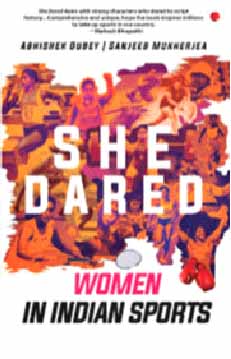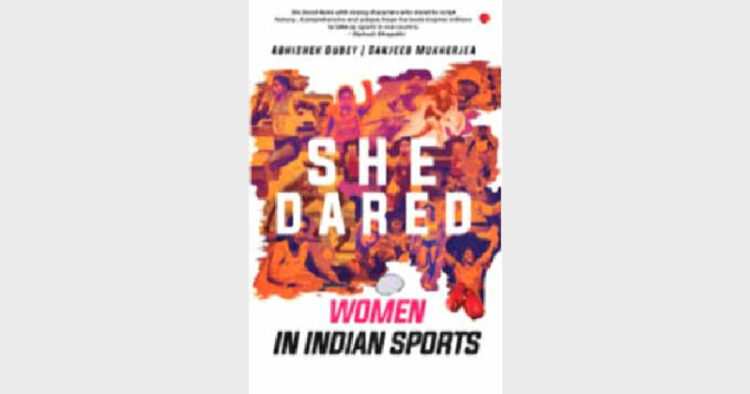
She Dared : Women in Indian Sports
by Abhishek Dubey, Sanjeeb Mukherjea
Published by Rupa Publication India,
Rs. 295, 296 Pages,
‘She Dared’ is an inspiring account of daring sportswomen who defied conventional wisdom while making path-breaking achievements in India’s sporting history
Yogesh Gulati
There is a crying need for quality sports literature in the country. And whatever literature is available follows a hackneyed path. For too long cricket has caught the imagination of the masses. Expectedly, bulk of the writing has been either on cricket or on cricketers. The writings on sports and sportspersons, other than cricket, have been far and few. Even in these selective writings, the focus has been more on hero worship of the champions. We rarely find any attempts to chronicle the sweat, blood, struggle and setbacks in the making of these champions. Amidst this backdrop, ‘She Dared’ – Women in Indian Sports, a fresh new read from Rupa, comes as a startling surprise, recounting the trials and tribulations of India’s top women athletes over the decades. This book is a comprehensive first account of sportswomen in Indian sports. The book has successfully managed to break many clichés in contemporary sports writing. In many sense, the book is an ideal template for story writing on sports.
The book makes a sedate but solid start. As the story progresses, it holds the reader’s interest through meticulous research and unique storytelling. The chapters are interspersed with interesting anecdotes. The first hand stories take us through a sort of sports tourism of the country. The places where the intrinsic character got forged are so vividly portrayed that these are sort of emerging as sports pilgrimage centres of the country.
The beginning of the book talks about how the initial women achievers represented the microscopic minority of the country. It sets the pace with the elaborate account on the girls from Kerala- most of them from humble backgrounds – as the breath of fresh air in the Indian sports. It talks about the huge transformative impact on Indian sports in terms of broadening the socio-economic base of Indian sports with the rise of PT Usha. The chapter on Ashwini Nachappa, her impact in terms of sportspersons life and the contribution of her Kodagu background is truly informative. The book rates Karnam Malleswari as the first Iron Lady of Indian sports and talks of her personality as being a perfect synthesis of the best of South and North. The narrative has been beautifully compared with the phenomenon of Saina Nehwal- the case of raw talent of Haryana getting fine-tuned in the laboratory of the badminton academies of Hyderabad. The chapter on Anju Bobby George has been interwoven in the backdrop of the man behind the success of the phenomenally successful Indian women athlete. The book adds a new dimension to the ‘Daughters Rise’ in Indian boxing and wrestling with the narrative of a compelling historicity. Through Mary Kom, the book goes on to explain the incredible North East being the definitive engine of India’s sports power. In the process, the way the socio-economic milieu of the North-Eastern states of India has been brought to fore tell us about the insight of the author on this region of the country. However, the stand alone chapters of the book go beyond all this.
Two chapters in the book is a ‘must-read’. The chapter on the Shanthi Soundarajan and Dutee Chand is a wonderful account of in-depth, engrossing and inclusive work. The manner in which their unique struggle has been brought to the fore will inspire many to fight against all odds. Importantly, the chapter talks about the maturing of the Indian system in handling such a sensitive issue to the extent of the same setting up the template for the rest of the world. Another chapter which takes this narrative of inclusiveness further is the one on the life of Deepa Malik. The topicality of the book has been maintained and one gets a sense of this while reading the chapter on PV Sindhu. The authors try to convey two underlying currents through this chapter. Firstly, most of the athletes before PV Sindhu, achieved their glories despite the system. The phenomenon of PV Sindhu, which the author calls ‘the great Indian badminton story,’ shows what Indian athletes could do when they get the best of the system. Secondly, if PV Sindhu wins a gold medal in the Tokyo Olympics 2020, she will go down as the all time greatest Indian sportsperson ever.
In a way, the narrative of the book takes its cue from the direction and focus of the present leadership. There are subtle references to this as well. Firstly, the book starts with the introduction where it talks about the initial women achievers of Indian sports having to be content with the autograph signed by the first Prime Minister of the country. The irony is not yet lost as the current Prime Minister Shri Narendra Modi proactively interacts with these athletes in both their highs and lows. Secondly, the book also discusses the fact that for the first time after decades, under the present leadership, those from amongst the masses are honored with the highest of the civilian awards. In this context, the reference of the Kalaripayattu has been mentioned in detail. In this manner, the passing of the legacy and tradition in Kerala has been succinctly compared with the trend of sportswomen of substance emerging with the regularity in the state. Thirdly, the seminal contribution of women of substance in Indian sports was highlighted in the inaugural independence day speech of PM Narendra Modi in 2014. In a sense the book clearly talks about extending the popular theme of ‘Beti Bachao Beti Padhao’ in Haryana to ‘Beti Bachao Beti Padhao Beti Khilao’.
The book, however, has got its share of shortcomings as well. The chapter on upcoming athletes should have been more elaborative. There may also be questions on some of the names which are not included. In this aspect, omissions from the team sports like cricket and football are particularly glaring. But then, the authors should be commended for their overall path breaking efforts. The book on the topic of the contribution of women in Indian sports coming from the mainstream journalists and that too with the sense of purpose is a heartening effort. This shows that sports writing could touch more serious narrative, can go beyond victories and defeats and include those as well which has been ignored by the mainstream media over the years as the matter of routine.
‘She Dared’ is a well-researched work that has the two authors bringing out the visceral journey of Indian women athletes through the ages. The manner of story-telling of the book is unique, refreshing and has the potential of raising the bar. In the writing on the subjects like this, the author has to cautiously walk between the book being substantive and getting too academic. One must say after reading the entire book that the authors have been able to strike out a fine balance between the two. This makes the book worth reading both as the first read and as a reference material for the people coming from across the sections of the society and belonging to the different age groups.
This book is a fascinating collection of narratives that will make readers aware that success is not simply about determination and foresight or even talent, it is also about survival.














Comments